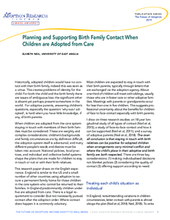Historically, adopted children would have no contact with their birth family, indeed this was seen as a virtue. This creates problems of identity for the child. For both the child and the birth family there are issues of ambiguous loss: the significant other is absent yet perhaps present somewhere in the world. For adoptive parents, answering children’s questions, especially the question ‘why was I adopted’, is hard when you have little knowledge, if any, of birth parents.
When children are adopted from the care system staying in touch with members of their birth families must be considered. These are weighty and complex considerations: children’s backgrounds and family circumstances are by definition difficult; the adoption system itself is adversarial; and many different people’s needs and desires must be taken into account. National policies, local practices, and individual and collective belief systems shape the plans that are made for children to stay in touch or not or with their birth relatives.
This research paper draws on the English experience. England is similar to the US and a small number of other countries using adoption to secure a permanent family home for those children in the care system who cannot be returned to their families. In England predominantly children under five are adopted from care. There is a legal requirement to consider (but not necessarily pursue) contact after the adoption order. Where contact does happen it is commonly voluntary.
Most children are expected to stay in touch with their birth parents, typically through letters that are exchanged via the adoption agency. About one third of children will meet with siblings, usually those who are in foster care or other adoptive families. Meetings with parents or grandparents occur for less than one in five children. This suggests professional uncertainty about the benefits for children of face to face contact especially with birth parents.
I draw on three research studies: an 18 year longitudinal study of all types of contact (Neil et al, 2015); a study of face-to-face contact and how it can be supported (Neil et al, 2011); and a survey of adoptive parents (Neil et al, 2018). The overall conclusion is that staying in touch with birth relatives can be positive for adopted children when arrangements carry minimal conflict and where the child’s place in their adoptive and birth family are both respected. There are three key considerations: (1) making individualised decisions not blanket policies (2) considering the quality of contact (3) offering support according to need.

